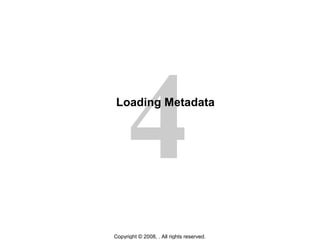
L04 loading metadata
- 1. 4 Copyright © 2008, . All rights reserved. Loading Metadata
- 2. Copyright © 2008, Oracle. All rights reserved. Objectives After completing this lesson, you should be able to: • Format metadata files • Set up dimensions • Manage multiple languages • Create import profiles • Run import profiles • View job status • Create interface tables
- 3. Copyright © 2008, Oracle. All rights reserved. Metadata Load Files Overview • You can load metadata from text files. • Load files can contain metadata for these items: – Account, Entity, Scenario, Custom, and ICP dimensions – Period, Year, and View dimensions – Value dimension – Currencies – Consolidation methods – Security classes – Aliases
- 4. Copyright © 2008, Oracle. All rights reserved. Formatting Metadata Load Files • Load files are divided into sections with an exclamation point as the delimiter defining the section header. • Sections can be in any order in the file. • The line defining the column names is immediately below the section header and begins with an apostrophe. • You can place the column names in any order. !Members=Standard Products 'Name;SwitchSignForFlow;SwitchTypeForFlow;IsCalculated [None] N;N;N AllProducts;Y;N;N Golf;Y;N;N GolfBalls;N;N;N Section header Column names
- 5. Copyright © 2008, Oracle. All rights reserved. Setting Up Dimensions For each dimension: • Add an entry to the DIMENSIONS section to define the dimension. • Add a !MEMBERS section to specify members and their properties. • Add a !HIERARCHIES section to specify parent-child relationships. • Add entries to the DIMENSIONASSOCIATIONS section for each member property with an association to another dimension.
- 6. Copyright © 2008, Oracle. All rights reserved. Dimensions Section • Add an entry for each dimension in the load file. • Include these required columns: Name and DimensionClass. !Section=Dimensions 'Name;DimensionClass;DefaultTopMember;DimensionAlias;CustomID GlobalCurrencies;Currency;#root; GlobalCurrencies; Calendar Months;Period;#root;CalendarMonths; Standard Scenario;Scenario;#root;Scenario; Standard Year;Year;#root;Year; Functional Entity;Entity;#root;Functional; AccountUSGAAPCommercial;Account;#root;GlobalCOA;
- 7. Copyright © 2008, Oracle. All rights reserved. Members Sections • Use a separate members section for each dimension. • Use Y for Yes and N for No. !Members=Standard Scenario 'Name;DefaultFrequency;DefaultView;ZeroViewForNonAdj;ZeroViewForAdj;Conso Actual;MTD;Periodic;Periodic;Periodic;N;10;Y;N;;Y;MTD; Budget;MTD;Periodic;Periodic;Periodic;N;10;Y;Y;;Y;MTD;
- 8. Copyright © 2008, Oracle. All rights reserved. Managing Languages !Members=T_Account 'Name;Alias=English;Alias=French;ConsolidationAccountType;IsCalculated;IsConsolidate AverageMonthlySales;Average Monthly Sales;Moyenne des ventes;Balance;Y;N;;TotalBusin AverageRate;Average Rate;Taux moyen;CurrencyRate;N;N;;;;;;6;Y;Y;Y;Y;;;N;N;SYSTEM;Y;; BankOverdraft;Bank Overdraft;Decouvert;TotalShortTermLiab;Liability;N;Y;;;;;ClosingB
- 9. Copyright © 2008, Oracle. All rights reserved. Hierarchy Sections • !HIERARCHY sections define parent-child relationships • Use this format: <parent member>;<child member> • Represent top-level members as children of #root: #root;<top-level member> !HIERARCHIES=Entity 'Parent;Child #root;Geographical Geographical;UnitedStates Geographical;Europe UnitedStates;California California;1000 California;Plant1 California;WestSales Entity Geographical UnitedStates California 1000 Plant1 WestSales Connecticut Mass Europe
- 10. Copyright © 2008, Oracle. All rights reserved. DimensionAssociations Section !Section=DimensionAssociations 'BaseDimension;Property;TargetDimension FunctionalEntity;SecurityClass;Security Classes FunctionalEntity;Currency;GlobalCurrencies
- 11. Copyright © 2008, Oracle. All rights reserved. Loading Metadata Process You perform the following tasks to load metadata: 1. Create an import profile. 2. Specify load options. 3. Map dimensions in the load file to dimensions in the Dimension Library. 4. Map columns in the load file to dimension properties in the Dimension Library. 5. Run the import profile.
- 12. Copyright © 2008, Oracle. All rights reserved. Creating Import Profiles
- 13. Copyright © 2008, Oracle. All rights reserved. Defining Load Options
- 14. Copyright © 2008, Oracle. All rights reserved. Mapping Dimensions Source File GlobalCurrencies Languages Shared Library C_Currency C_Alias
- 15. Copyright © 2008, Oracle. All rights reserved. Mapping Properties Maps fields to member properties
- 16. Copyright © 2008, Oracle. All rights reserved. Running Import Profiles
- 17. Copyright © 2008, Oracle. All rights reserved. Viewing Job Status
- 18. Copyright © 2008, Oracle. All rights reserved. Process for Loading Metadata from Interface Tables Interface tables Relational database Performance Management Architect
- 19. Copyright © 2008, Oracle. All rights reserved. Summary In this lesson you should have learned to: • Format metadata files • Set up dimensions • Manage multiple languages • Create import profiles • Run import profiles • View job status • Create interface tables
Editor's Notes
- The Year, Period, and View dimensions are defined in the application profile. For system generated members, you can modify but not add metadata. For example, you can modify the description and security class for members of the ICP dimension, but you cannot add members.
- You define the metadata dimension members in a Members section. You can represent missing values as empty, using delimiters. To begin a Members section, enter the following line, replacing the [&lt; &gt;] characters with the dimension name: !MEMBERS=&lt; &gt;
- To begin a Hierarchies section, enter the following line, replacing [&lt;&gt;] with the dimension name: !HIERARCHIES=&lt;&gt; Do not include spaces when starting sections for dimensions. For example, begin the Hierarchies section for the Custom 1 dimension with the following line: !HIERARCHIES=Custom1
